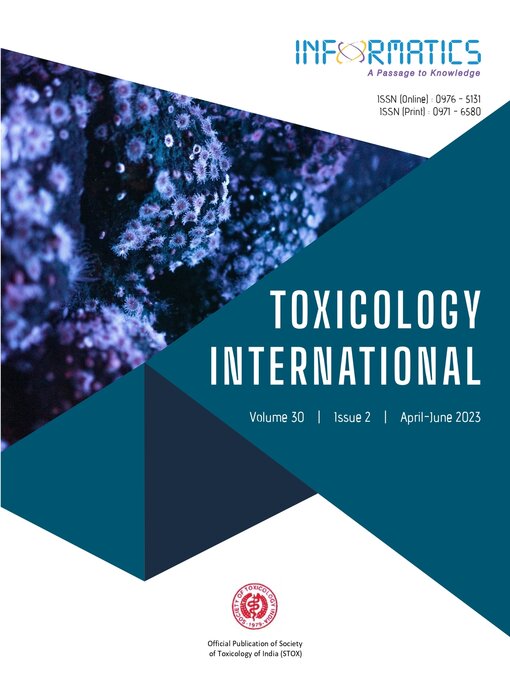Safety Evaluation of Arsenicum album in Acute and Sub-Acute Toxicity Studies in Rats
DOI:
https://doi.org/10.18311/ti/2023/v30i2/32299Keywords:
Complementary and Alternative Medicines, Homoeopathy, Safety, ToxicityAbstract
Arsenic album is frequently prescribed in homoeopathy for many diseases. However, its safety data is not available. Thus, the study’s purpose is to evaluate the oral toxicity of Arsenic album 6C, 30C, and 200C in rats. Arsenic album (6C, 30C, and 200C) was given at 2000 μl/kg for acute toxicity and observed for up to 14 days. For subacute toxicity, it was given for 28 days and observed for clinical signs, change in body weight and Mortality. Hematological, biochemical, organ weight and histopathological analyses were assessed. Results indicate no mortality of arsenic album in acute toxicity and LD50 is >2000 μl/kg. In the subacute toxicity study, arsenic album (200 μl/kg) did not show any significant changes in above parameters. It may be concluded that the arsenic album (6C, 30C, and 200C) is safe and produces no toxicity when administered orally for a prolonged duration at 200 μl/kg in rats.
Downloads
Published
How to Cite
Issue
Section
Accepted 2023-02-16
Published 2023-05-23
References
Briggs CJ, Norrie O. Regulation of herbal and homeopathic medicines. Pharm Dev Regul. 2003; 1:245-259. https://doi. org/10.1159/000507952 DOI: https://doi.org/10.1007/BF03257384
WHO. Safety issues in the preparation of homeopathic medicines. 2009. Retrieved from: https://apps.who.int/iris/ handle/10665/44238
Singh S, Kumar R, Karwasra R, Kalra P, Rani S, Nayak D, et al. Evaluation of safety profile of homoeopathic mother tinctures. Indian J Res Homoeopathy. 2014; 8:81-86. https:// doi.org/10.4103/0974-7168.135640 DOI: https://doi.org/10.4103/0974-7168.135640
Habs M, Koller M. Material risks of homeopathic medicinal products: Regulatory frameworks, results of preclinical toxicology, and clinical meta-analyses and their implications. Complement Med Res. 2021; 28:64-84. https://doi.org/10.1159/000507952 DOI: https://doi.org/10.1159/000507952
Manchanda RK. Popularity, safety and quality of homoeopathic medicines. Indian J Res Homoeopathy. 2018; 12:191. https://doi.org/10.4103/ijrh.ijrh_72_18 DOI: https://doi.org/10.4103/ijrh.ijrh_72_18
Sharma M, Prajapati S, Kumar A, Tripathi A, GVN Kumar, Gupta P. Effect of acute exposure of belladonna mother tincture on zebrafish embryonic development. Indian J Pharm Sci. 2021; 83:5. https://doi.org/10.36468/pharmaceutical- sciences.847 DOI: https://doi.org/10.36468/pharmaceutical-sciences.847
Sharma M, Prajapati S, Kumar A, Tripathi A, GVN Kumar, Gupta P. Safety evaluation of Syzygium jambolanum on the development of zebrafish embryos. Indian J Pharm Educ Res. 2021; 55(1):198-204. https://doi.org/10.5530/ ijper.55.1.22 DOI: https://doi.org/10.5530/ijper.55.1.22
Kirby BJ. Safety of homeopathic products. J R Soc Med. 2002; 95(5):221-222. https://doi.org/10.1258/jrsm.95.5.221 DOI: https://doi.org/10.1258/jrsm.95.5.221
Clarke JH. A dictionary of practical materia medica. Homoeopathic Publishing Company. 1902
Bellavite P, Signorini A, Marzotto M, Moratti E, Bonafini C, Olioso D. Cell sensitivity, non-linearity and inverse effects. Homeopathy. 2015; 104:139-160. https://doi.org/10.1016/j. homp.2015.02.002 DOI: https://doi.org/10.1016/j.homp.2015.02.002
Kundu S, Mitra K, Bukhsh AK. Efficacy of a potentized homeopathic drug (Arsenicum-Album-30) in reducing cytotoxic effects produced by arsenic trioxide in mice: IV. Pathological changes, protein profiles, and content of DNA and RNA. Complement Ther Med. 2000; 8:157-165. https:// doi.org/10.1054/ctim.2000.0390 DOI: https://doi.org/10.1054/ctim.2000.0390
Mallick P, Chakrabarti Mallick J, Guha B, Khuda-Bukhsh A. Ameliorating effect of microdoses of a potentized homeopathic drug, Arsenicum album, on arsenic-induced toxicity in mice. BMC Complement Altern Med. 2003; 3:1- 13. https://doi.org/10.1186/1472-6882-3-7 DOI: https://doi.org/10.1186/1472-6882-3-7
Ive EC, Couchman I, Reddy L. Therapeutic effect of Arsenicum album on leukocytes. Int J Mol Sci. 2012; 13:3979-3987. https://doi.org/10.3390/ijms13033979 DOI: https://doi.org/10.3390/ijms13033979
Das D, De A, Dutta S, Biswas R, Boujedaini N, Khuda- Bukhsh AR. Potentized homeopathic drug Arsenicum Album 30C positively modulates protein biomarkers and gene expressions in Saccharomyces cerevisae exposed to arsenate. J Chin Integr Med. 2011; 9:752-760. https://doi. org/10.3736/jcim20110709 DOI: https://doi.org/10.3736/jcim20110709
Ernst E. The efficacy of herbal medicine–an overview. Fundam Clin Pharmacol. 2005; 19:405-409. https://doi. org/10.1111/j.1472-8206.2005.00335.x DOI: https://doi.org/10.1111/j.1472-8206.2005.00335.x
OECD Test No. 423. Acute oral toxicity-Acute toxic class method. 2002. Retrieved from: https://www.oecd-ilibrary. org/environment/test-no-423-acute-oral-toxicity-acutetoxic- class-method_9789264071001-en
OECD Test No. 407. Repeated Dose 28-day Oral Toxicity Study in Rodents. 2008. https://doi.org/10.1787/ 9789264070684-en
Olfert E, Bhasin J, Latt R, McCutcheon K, Rainnie D, Schunk M. CCAC Guidelines on: Choosing an appropriate endpoint in experiments using animals for research, teaching and testing. 1998. Retrieved from: https://ccac.ca/ Documents/Standards/Guidelines/Appropriate_endpoint. pdf
Chitra B, Ramaswamy R, Suba V. Toxicity evaluation of Purn. a Cantirotaya Centuram, a Siddha medicine in Wistar rats. Int Sch Res Notices. 2015; 473296. https://doi. org/10.1155/2015/473296 DOI: https://doi.org/10.1155/2015/473296
Wren AF, Cleary M, Frantz C, Melton S, Norris L. 90-day oral toxicity study of a grape seed extract (IH636) in rats. J Agric Food Chem. 2002; 50:2180-2192. https://doi. org/10.1021/jf011066w DOI: https://doi.org/10.1021/jf011066w
Rao JV. Toxic effects of novel organophosphorus insecticide (RPR-V) on certain biochemical parameters of euryhaline fish, Oreochromis mossambicus. Pestic Biochem Phys. 2006; 86:78-84. https://doi.org/10.1016/j.pestbp.2006.01.008 DOI: https://doi.org/10.1016/j.pestbp.2006.01.008
Mukinda JT, Syce JA. Acute and chronic toxicity of the aqueous extract of Artemisia afra in rodents. J Ethnopharmacol. 2007; 112:138-144. https://doi. org/10.1016/j.jep.2007.02.011 DOI: https://doi.org/10.1016/j.jep.2007.02.011
Olson H, Betton G, Robinson D, Thomas K, Monro A, Kolaja G, et al. Concordance of the toxicity of pharmaceuticals in humans and in animals. Regul Toxicol Pharmacol. 2000; 32:56-67. https://doi.org/10.1006/rtph.2000.1399 DOI: https://doi.org/10.1006/rtph.2000.1399
Olorunnisola O, Bradley G, Afolayan A. Acute and subchronic toxicity studies of methanolic extract of Tulbaghia violacea rhizomes in Wistar rats. Afr J Biotechnol. 2012, 11:14934-4940
Anderson N, Borlak J. Molecular mechanisms and therapeutic targets in steatosis and steatohepatitis. Pharmacol Rev. 2008; 60:311-357. https://doi.org/10.1124/pr.108.00001 DOI: https://doi.org/10.1124/pr.108.00001
Schalm OW. Schalm’s veterinary hematology; 2000
Loge JP, Lange RD, Moore CV. Characterization of the anemia associated with chronic renal insufficiency. Am J Med.1958; 24:4-18. https://doi.org/10.1016/0002- 9343(58)90357-7 DOI: https://doi.org/10.1016/0002-9343(58)90357-7
Wallig MA, Bolon B, Haschek WM, Rousseaux CG. Fundamentals of toxicologic pathology. Academic press; 2017
Nigatu TA, Afework M, Urga K, Ergete W, Makonnen E. Toxicological investigation of acute and chronic treatment with Gnidia stenophylla Gilg root extract on some blood parameters and histopathology of spleen, liver and kidney in mice. BMC research notes. 2017; 10:1-13. https://doi. org/10.1186/s13104-017-2964-3 DOI: https://doi.org/10.1186/s13104-017-2964-3
Michael B, Yano B, Sellers RS, Perry R, Morton D, Roome N, et al. Evaluation of organ weights for rodent and nonrodent toxicity studies: A review of regulatory guidelines and a survey of current practices. Toxicol Pathol. 2007; 35:742-750. https://doi.org/10.1080/01926230701595292 DOI: https://doi.org/10.1080/01926230701595292
 Roshan Lal
Roshan Lal







